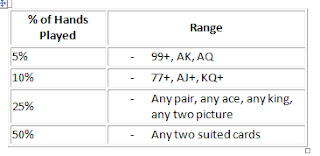Hopefully it'll spur your interest to learn more about this fascinating game on your own!
Let's get started with the most fundamental of them all - The 2 cards you get.
We know there's a certain % for each combination of 2 cards that you can get.
For example, everyone knows AA is the strongest starting hand in this game, and based on mathematical probability, you'll get them about once every 221 hands.*
KK is the next strongest.
Then comes QQ, then AK / JJ......
Since no one in the right mind folds AA and plays 23, we can conclude something:
The less % of hands one play, the stronger his hand is on average. The more % of hands he plays, the weaker it is on average.
Example:
Let's say you meet a super tight opponent that keeps folding - playing only about once every 100 hands, or 1% of all his hand.
What do you think he's playing? Probably only KK and AA.
You can therefore say that his range, the likely cards he's holding, is "KK+", meaning pocket pair KK and stronger.
If you understand the above:
Below is a simplified chart of % of hands played and the range of cards it comprises. You can think of it as arranging all possible combinations of 2 cards from strongest to weakest, with each row representing the top X%.
Now, here's a test.
Suppose you're playing against an opponent who plays about 1 every 10 dealt hands, and the flop comes:
1) 5 6 7
2) A J K
Can you tell which of these 2 flops is most likely to have helped him?
Suppose you have 22, would you rather have the first or the 2nd flop against this particular opponent?
If you can answer this question (and know the reasoning), you would already have a great advantage over many other players in this game.
*There are (52 x 51 / 2) = 1326 possible starting hand combinations. There are (4 x 3 / 2) = 6 possible pocket AA combinations. 6 out of 1326 is 1 every 221 hands.



No comments:
Post a Comment